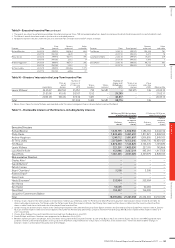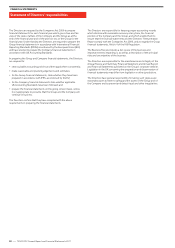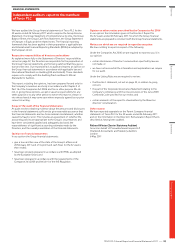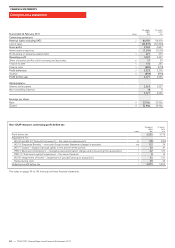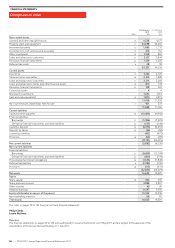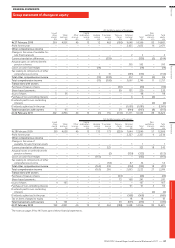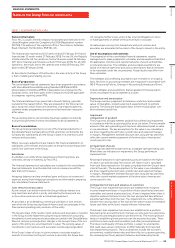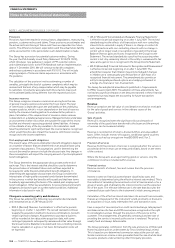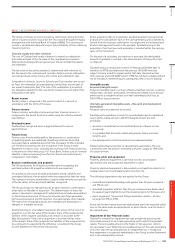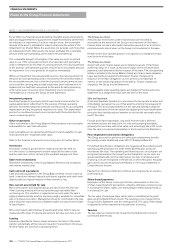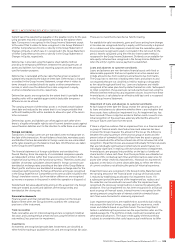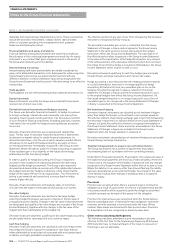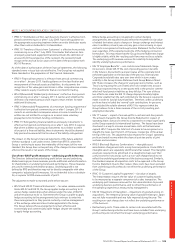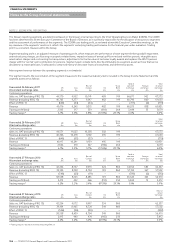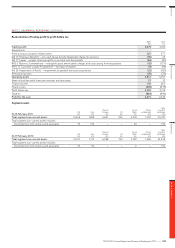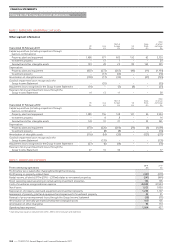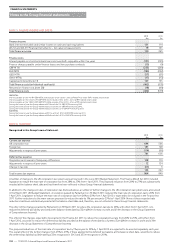Tesco 2011 Annual Report Download - page 105
Download and view the complete annual report
Please find page 105 of the 2011 Tesco annual report below. You can navigate through the pages in the report by either clicking on the pages listed below, or by using the keyword search tool below to find specific information within the annual report.
The Group continues to receive insurance commission arising from the
sale of insurance policies sold under the Tesco brand through the legacy
arrangement with the Royal Bank of Scotland (RBS). This commission
income is variable and dependent upon the profitability of the underlying
insurance policies.
Clubcard, loyalty and other initiatives
The cost of Clubcard and loyalty initiatives is treated as a deduction
from sales and part of the fair value of the consideration received is
deferred and subsequently recognised over the period that the awards
are redeemed.
The fair value of the points awarded is determined with reference to
the fair value to the customer and considers factors such as redemption
via Clubcard deals versus money-off-in-store and redemption rate.
Computers for Schools, Sport for Schools and Club vouchers are issued
by Tesco for redemption by participating schools/clubs and are part of
our overall Community Plan. The cost of the redemption (i.e meeting
the obligation attached to the vouchers) is treated as a cost rather than
a deduction from sales.
Rental income
Rental income is recognised in the period in which it is earned, in
accordance with the terms of the lease.
Finance income
Finance income, excluding income arising from financial services, is
recognised in the period to which it relates using the effective interest
rate method.
Dividend income
Dividends are recognised when a legal entitlement to receive
payment arises.
Finance costs
Finance costs directly attributable to the acquisition or construction
of qualifying assets are capitalised. Qualifying assets are those that
necessarily take a substantial period of time to prepare for their intended
use. All other borrowing costs are recognised in the Group Income
Statement in finance costs, excluding those arising from financial services,
in the period in which they occur. For Tesco Bank, finance cost on financial
liabilities is determined using the effective interest rate method and is
recognised in cost of sales.
Business combinations and goodwill
The Group accounts for all business combinations by applying the
purchase method. All acquisition-related costs are expensed.
On acquisition, the assets (including intangible assets), liabilities and
contingent liabilities of an acquired entity are measured at their fair value.
The interest of minority shareholders is stated at the minority’s proportion
of the fair values of the assets and liabilities recognised.
The Group recognises intangible assets as part of business combinations
at fair value on the date of acquisition. The determination of these fair
values is based upon management’s judgement and includes assumptions
on the timing and amount of future incremental cash flows generated
by the assets acquired and the selection of an appropriate cost of capital.
The useful lives of intangible assets are estimated and amortisation is
charged on a straight-line basis.
Goodwill arising on consolidation represents the excess of the cost of an
acquisition over the fair value of the Group’s share of the net assets/net
liabilities of the acquired subsidiary, joint venture or associate at the
date of acquisition. If the cost of acquisition is less than the fair value
of the Group’s share of the net assets/net liabilities of the acquired entity
(i.e a discount on acquisition), the difference is credited to the Group
Income Statement in the period of acquisition.
At the acquisition date of a subsidiary, goodwill acquired is recognised as
an asset and is allocated to each of the cash-generating units expected to
benefit from the business combination’s synergies and to the lowest level
at which management monitors the goodwill. Goodwill arising on the
acquisition of joint ventures and associates is included within the carrying
value of the investment.
On disposal of a subsidiary, joint venture or associate, the attributable
amount of goodwill is included in the determination of the profit or loss
on disposal.
Goodwill arising on acquisitions before 29 February 2004 (the date of
transition to IFRS) was retained at the previous UK GAAP amounts
subject to being tested for impairment at that date. Goodwill written
off to reserves under UK GAAP prior to 1998 has not been restated and will
not be included in determining any subsequent profit or loss on disposal.
Intangible assets
Acquired intangible assets
Acquired intangible assets, such as software, pharmacy licences, customer
relationships, contracts and brands, are measured initially at cost and are
amortised on a straight-line basis over their estimated useful lives, at
2%-100% of cost per annum.
Internally-generated intangible assets – Research and development
expenditure
Research costs are expensed as incurred.
Development expenditure incurred on an individual project is capitalised
only if all the criteria set out in IAS 38 ‘Intangible Assets’ are met,
principally:
• an asset is created that can be identified (such as software or new
processes);
• it is probable that the asset created will generate future economic
benefits; and
• the development cost of the asset can be measured reliably.
Following the initial recognition of development expenditure, the cost
is amortised over the project’s estimated useful life, usually at 14%-25%
of cost per annum.
Property, plant and equipment
Property, plant and equipment is carried at cost less accumulated
depreciation and any recognised impairment in value.
Property, plant and equipment is depreciated on a straight-line basis to its
residual value over its anticipated useful economic life.
The following depreciation rates are applied for the Group:
• freehold and leasehold buildings with greater than 40 years unexpired –
at 2.5% of cost;
• leasehold properties with less than 40 years unexpired are depreciated
by equal annual instalments over the unexpired period of the lease; and
• plant, equipment, fixtures and fittings and motor vehicles – at rates
varying from 9% to 50%.
Assets held under finance leases are depreciated over their expected useful
lives on the same basis as owned assets or, when shorter, over the term of
the relevant lease.
Impairment of non-financial assets
Goodwill is reviewed for impairment at least annually by assessing the
recoverable amount of each cash-generating unit to which the goodwill
relates. The recoverable amount is the higher of fair value less costs to
sell, and value in use. When the recoverable amount of the cash-generating
unit is less than the carrying amount, an impairment loss is recognised.
Any impairment is recognised immediately in the Group Income Statement
and is not subsequently reversed.
NOTE 1 ACCOUNTING POLICIES CONTINUED
TESCO PLC Annual Report and Financial Statements 2011
—
101
Overview Business review Governance Financial statements


